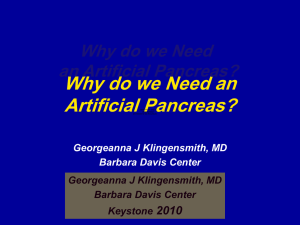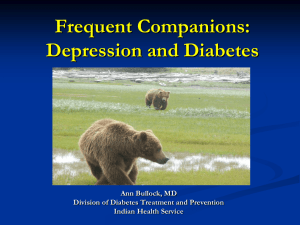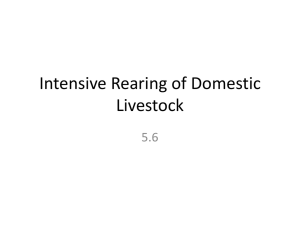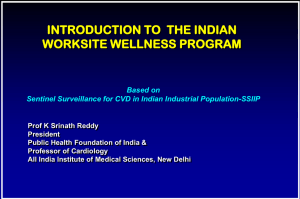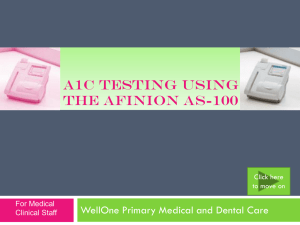N Engl J Med
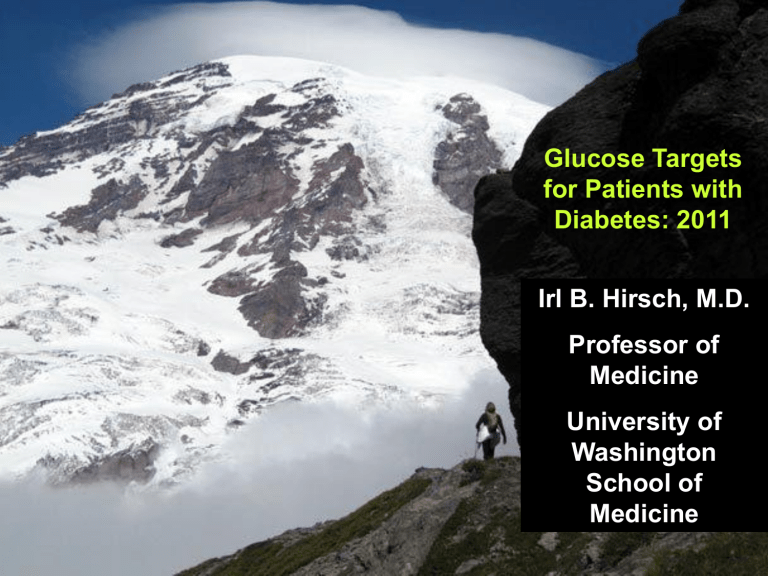
Glucose Targets for Patients with
Diabetes: 2011
Irl B. Hirsch, M.D.
Professor of
Medicine
University of
Washington
School of
Medicine
The Problem With Today’s Glycemic
Guidelines
There are always caveats!
Part of the Problem:
We keep changing the targets!
What to consider in November, 2011
Case 1
A 55-year-old man with type 1 diabetes for 51 years
• 20 years ago, he required laser surgery on both of his eyes
• Otherwise, he has no albuminuria, minimal neuropathy, and no history of heart disease
Case 1 (cont.)
Based on this patient’s history, his A1C target should be:
A.
<6.5%
B.
<7.0%
C.
<7.5%
D.
<8.0%
E.
As low as reasonable without excessive hypoglycemia
Conclusions from Studies of Type 1 Diabetes
• Intensive control of type 1 diabetes prevents the development and reduces the progression of microvascular disease. (DCCT Research Group. N Engl
J Med . 1993;329:977-986.)
• Intensive control of type 1 diabetes early in the course of disease prevents the development of macrovascular disease years later. (DCCT/EDIC Research Group. N
Engl J Med . 2005;353:2643-2653.)
• The major risk of this therapy is hypoglycemia, but these episodes have no long-term cognitive consequences
(DCCT/EDIC Research Group. N Engl J Med .
2007;356:1842-1852.)
Type 1 Diabetes:
What Else to Consider
• The DCCT need not be extrapolated to young children or older adults with >20-25 years of type 1 diabetes.
• Glycemic goals for these populations (both growing in the United States) for primary prevention or secondary intervention of microor macrovascular complications are not clear and not evidence-based.
What About Type 2 Diabetes?
Type 2 Diabetes:
UKPDS Intensive Therapy (Sulfonylurea/Insulin
)
• Population: newly diagnosed patients with type 2 diabetes, at high risk for myocardial infarction
(MI) but having little to no cardiovascular disease (CVD) when entering the study
• Microvascular disease: reduced 21-34%
(all P <0.01)
• MI: reduced 16% ( P = 0.052)
U.K. Prospective Diabetes Study Group. Lancet. 1998;352:837 –853.
But what about the big problem of glycemic control and macrovascular disease
(CAD, CVD, PVD) in long-
standing type 2 diabetes?
Macrovascular Disease and
Type 2 Diabetes
• About two-thirds of all people with type 2 diabetes die from CVD.
• There is major suffering and loss of productivity from micro vascular disease.
• Epidemiological and prospectively followed populations show a relationship between CVD and glycemia.
• Intervention studies up until 2009 have not been as clear.
What Was the Highlight of 2008?
Knowing that Sarah Palin could see
Russia from her house?
No!
• The report of FOUR LANDMARK studies to better characterize the impact of glycemic control and CVD
ADA 2008:
ACCORD Versus ADVANCE
• ACCORD = Action to Control Cardiovascular
Risk in Diabetes
• ADVANCE = Action in Diabetes and Vascular
Disease: Preterax and Diamicron Modified
Release Controlled Evaluation
• Both published June 12, 2008, in the New
England Journal of Medicine
• Both large studies of patients with established type 2 diabetes with primary endpoint of new
CVD events
VA Diabetes Trial (VADT)
• Similar study design: intensive therapy versus standard therapy
• Primary endpoint: first CVD event after randomization
• Subjects with longer durations of diabetes, more
CVD, higher baseline A1C
Duckworth W, Abraira C, Moritz T, et al. N Engl J Med . 2009;360:129-139.
Differences in ACCORD/ADVANCE/VADT
Skyler JS, Bergenstal R, Bonow RO, et al. Diabetes Care. 2009;32:187-192.
Results of the Randomized Comparison of an
Intensive Versus a Standard Glycemic Strategy
P-value
All-cause mortality
Primary endpoint:
CV death, MI, stroke
Unadjusted HR for
Intensive vs. Standard (95% CI)
1.22 (1.01-1.46)
0.90 (0.78-1.04)
CV death
Non-fatal MI
Non-fatal stroke
1.35 (1.04-1.76)
0.76 (0.62-0.92)
1.06 (0.75-1.50)
0.04
0.16
0.02
0.004
0.74
Gerstein HC et al. The ACCORD Study Group. N Engl J Med. 2008;358:2545–2559.
Baseline Characteristics:
HR for Death with Intensive Versus Standard Strategies for Baseline Subgroups
Subgroup
Risk of Death (all-cause) in Intensive vs. Standard Glycemia
Interaction P
Standard Glycemia
% Deaths (N)
Intensive Glycemia
% Deaths (N)
0.0444
0.044
4.40% (1022)
4.09% (2200)
3.60% (1887)
4.83% (1036)
4.18% (2226)
6.14% (1857)
4.11% (1410)
3.84% (3646)
7.84% (1327)
4.10% (3708)
3.83% (2771)
4.12% (2352)
5.73% (2808)
4.14% (2320)
0
0
Intensive Therapy Better
1
1 2
2
3
3
Standard Therapy Better
4
4
Calles-Escandon, Lovato LC,
Simons-Morton DG, et al.
Diabetes Care. 2010;33:721-
727.
5-Year Outcomes After 3.7 Yrs
Intensive Therapy
NEJM 2011;364:818-28
So What Can We Conclude About
Hypoglycemia in ACCORD?
How in the World Do We
Interpret This?
Conclusion from Epidemiological
Analyses of the Whole Population
As in other trials, higher average A1C in ACCORD associates with higher risk of death
For 1% higher A1C
HOPE
UKPDS
ACCORD
+12%
+14%
+22%
Riddle MC, Ambrosius WT, Brillon DJ, et al. Diabetes Care . 2010;33:983-990.
Association of Average A1C with Mortality by Strategy:
Cox Proportional Hazards Model Adding Glycemic
Strategy Assignment to Other Covariates
Hazard ratio for 1% higher average A1C (95% CI)
Intensive strategy 1.66 (1.46, 1.89)
Standard strategy 1.14 (0.95, 1.38)
P = 0.0001
P = 0.17
Interaction between Intensive and Standard P = 0.0007
The relationships between average A1C and mortality differed between treatment strategies
Riddle MC, Ambrosius WT, Brillon DJ, et al. Diabetes Care . 2010;33:983-990.
Risk of Cardiovascular Death over a Range of Average
A1C Levels for the Intensive and Standard Strategies
Steady increase of risk from 6 to 9% A1C with intensive strategy
CV Death
Intensive Strategy
Riddle MC,
Ambrosius WT,
Brillon DJ, et al.
Diabetes Care .
2010;33:983-990.
Standard Strategy
6 7
Average A1C
8
U-shaped curve with standard strategy
9
Rates of Death During 3.4 Years of Treatment over a Range of 1-year Change of A1C
Adjusted Mortality Rates by Treatment Strategy
Riddle MC,
Ambrosius WT,
Brillon DJ, et al.
Diabetes Care .
2010;33:983-990.
A1C decline from baseline over 12 months (%)
0.0
0.5
1.0
1.5
2.0
Excess risk with intensive vs. standard strategy occurred when intensive participants failed to reduce A1C in year 1
Questions About the Primary Composite
Endpoint and Its Components
• Are risks of cardiovascular death, MI, and stroke all greater with higher A1C in the whole
ACCORD population?
• Are the relationships between A1C and these endpoints different for the intensive and standard strategies?
• How do cardiovascular death and non-fatal MI differ with the intensive strategy?
CV death
n = 229
Associations of Average A1C with
Cardiovascular Death, MI, and Stroke
Cox Proportional Hazards Models
Hazard Ratios for 1% greater value (95% CI)
Unadjusted
1.21 (1.04-1.40)
P = 0.01
Adjusted for baseline, site, and post-randomization factors
1.19 (1.02-1.39)
P = 0.0001
Non-fatal MI
n = 421
1.20 (1.08-1.33)
P = 0.0007
1.20 (1.08-1.34)
P = 0.0007
Non-fatal stroke
n = 128
1.23 (1.03-1.46)
P = 0.02
1.18 (0.99-1.40)
P = 0.07
Risk of each CV outcome is greater with higher average A1C
Riddle MC, Ambrosius WT, Brillon DJ, et al. Diabetes Care . 2010;33:983-990.
What Should You Take Away from This?
• An intensive glycemic treatment strategy was associated with a higher risk of death over 3.4 years of follow-up
• In the whole population, a 20-22% greater risk of death was associated with each 1% higher average A1C
• Higher risk of death with an intensive than with a standard strategy was associated with three baseline characteristics:
– A1C ≥8.5%
– History of neuropathy
– History of aspirin use
More Take-Away Points
• The excess risk of death with intensive treatment occurred in participants:
– Whose average A1C was >7%, not <7%
– Who did not reduce A1C from baseline in the first year
• Relationships differed between intensive and standard strategies; with an intensive strategy:
– Risk of all-cause and cardiovascular death was higher when average A1C was >7%
– Risk of MI was lower when A1C was <7%
ADVANCE
ADVANCE Collaborative Group, et al. N Engl J Med . 2008;358:2560-2572.
ADVANCE: Primary Outcomes
ADVANCE Collaborative Group, et al. N Engl J Med . 2008;358:2560-2572.
ADVANCE: Primary Outcomes (cont.)
ADVANCE Collaborative Group, et al. N Engl J Med . 2008;358:2560-2572.
ADVANCE
ADVANCE Collaborative Group, et al. N Engl J Med . 2008;358:2560-2572.
ADVANCE: Secondary Endpoints
• All-cause mortality: P = NS
• Total renal events: 11% RR with intensive,
P <0.001
• Eye events: P = NS
• CHF, PVD, neuropathy: P = NS
ADVANCE Collaborative Group, et al. N Engl J Med . 2008;358:2560-2572.
VADT
• 1,791 subjects; intensive versus conventional therapy; primary endpoint cardiovascular events
• Baseline A1C: 9.5%
− Standard: 8.4%
− Intensive: 6.9% (6 months)
Duckworth W, Abraira C, Moritz T, et al. N Engl J Med . 2009;360:129-139.
VADT: Final Results
Non-significant 12% decrease in composite CVD in IT
Standard (n = 899) Intensive (n =92)
Incidence (%)
264 (33.5)
Incidence (%)
235 (29.5)
P-value
0.14
Exploratory analyses (presented but not published) suggested that severe hypoglycemia within the past
90 days was a strong predictor of the primary outcome and of CVD mortality.
And . . .
Hazard Ratio for Primary Outcome in Intensive Arm by Duration of Diabetes
P < 0.05
P <0.05
P = NS
But What About Microvascular
Disease in VADT?
• Initial publication: no evidence of improvement in endpoints
• But . . . on September 3, 2009, a correction is reported in the New England Journal of Medicine
– Error was discovered in the initial computer code; actual results were different from those initially reported
– Progression from normal to microalbuminuria was significant ( P = 0.04) and progression from micro- to macroalbuminuria was also significant ( P = 0.03), favoring intensive therapy
What This Means:
As in the ADVANCE trial, the VADT showed an improvement in the primary renal outcome, despite the fact that these patients were much more advanced in their disease process than those in the UKPDS.
Maybe the Most Important Report from 2008
But the one that gets the least respect
UKPDS
• Newly diagnosed type 2 diabetes; intensive versus conventional policy; primary report published September
1998
• Follow-up observation published October 2008
Holman RR, Paul SK, Bethel MA, Neil HA, Matthers
DR. N Engl J Med . 2008;359:1565-1576.
Post-Trial Changes in A1C
Mean (95%CI)
UKPDS results presented
Holman RR, Paul SK, Bethel MA, Neil HA, Matthers DR. N Engl J Med . 2008;359:1565-1576.
MI Hazard Ratio
Fatal or Non-Fatal MI or Sudden Death )
Intensive (Sulfonylurea/Insulin) Versus Conventional Glucose Control
HR (95%CI)
Holman RR, Paul SK, Bethel MA, Neil HA, Matthers DR. N Engl J Med . 2008;359:1565-1576
.
Legacy Effect of Earlier Glucose Control
After median 8.5 years post-trial follow-up
Aggregate Endpoint
Any diabetes-related endpoint
Microvascular disease
Myocardial infarction
All-cause mortality
1997
RRR: 12%
P: 0.029
RRR: 25%
P: 0.0099
RRR: 16%
P: 0.052
RRR:
P:
6%
0.44
2007
9%
0.040
24%
0.001
15%
0.014
13%
0.007
RRR = Relative Risk Reduction, P = Log Rank
Holman RR, Paul SK, Bethel MA, Neil HA, Matthers DR. N Engl J Med . 2008;359:1565-1576.
Impact of Intensive Therapy in Diabetes Summary of
Major Clinical Trials
Study
DCCT/EDIC
UKPDS
ACCORD
ADVANCE
VADT
Microvascular
↓
↓
↓
↓
↓
↓
↓
↔
↔
CVD
↓
↓
↔
↔
↔
↔
↔
Mortality
↔
↓
↑
↔
↔
Initial Trial
Long Term Follow-up
Big Picture Messages
• Type 1 and type 2 diabetes: early meticulous glucose control can prevent microvascular and neuropathic complications
• Type 1 and type 2 diabetes: early meticulous glucose control appears to prevent CVD many years later (“metabolic memory” and “legacy effect”)
More Big Picture Messages
• Type 2 diabetes: patients with known CVD or a long duration of diabetes may be harmed by meticulous control; although the mechanism(s) for this are not known, the leading candidate mechanism is hypoglycemia
Still More Big Picture Messages
• Type 1 diabetes: impact of glycemia on microvascular disease not present after 20-25 years (probably true for type 2 diabetes, too)
• After long duration of either type 1 or type 2 diabetes (or known CVD), it appears that blood pressure and LDL cholesterol levels better predict CVD mortality than A1C
• Impact of hypoglycemia is not consistent between populations (children <5 years of age, geriatrics, inpatients)
So, What Are the A1C Targets?
A1C TARGETS
• Several societies have published targets, but it is clearly complicated as so many factors involved, in addition to the fact A1C itself is at best a fair marker of average glycemia for an individual patient
• Our thoughts…
Individualizing Glycemic Targets in T2DM
Most Intensive
6.0%
Less Intensive
7.0%
Least Intensive
8.0%
Highly Motivated, Adherent,
Knowledgeable,
Excellent Self-Care Capacities,
& Comprehensive Support Systems
Low
Psychosocioeconomic Considerations
Less motivated, Non-adherent,
Limited insight,
Poor Self-Care Capacities,
& Weak Support Systems
Hypoglycemia Risk
Moderate High
40 45 50 55 60 65 70
Patient Age
75
Disease Duration
20 5 10 15
Few /Mild
Other Comorbidities
Multiple/Severe
None
None
Established Vascular Complications
Early Micro
Cardiovascular
Advanced Micro
Ismail-Beigi, F., et al. Ann Inter Med. 154:554-559, 2011
Ismail-Beigi, F., et al. Ann Inter Med. 154:554-559, 2011
Individualized Targets
• The available evidence, albeit limited, suggests that in younger patients with relatively recent onset of T2DM and little, if any, micro- and macrovascular complications, near-normal glycemic targets should be the standard. Here, the aim is to help prevent complications over the many years of life. In older individuals with longstanding
T2DM and evidence of CVD (or multiple CVD risk factors), somewhat higher targets should be considered.
Ann Inter Med. 154:554-559, 2011
Metabolic Control: Bottom Line
Mother Nature keeps score.*
*especially early in the course of diabetes

